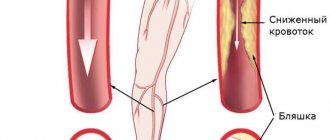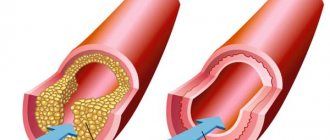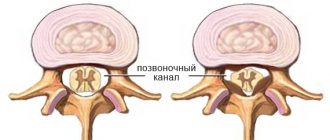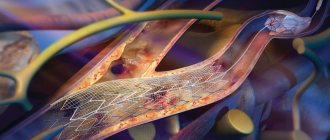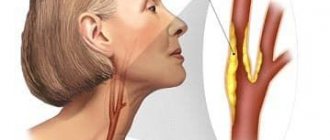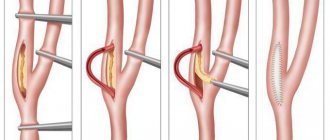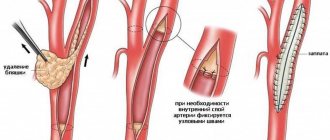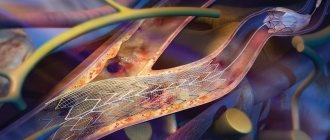Diagnosis of atherosclerosis of the carotid arteries
To prevent atherosclerosis of the carotid arteries from becoming a life-threatening diagnosis, careful examination and proper treatment are needed.
After a meeting with a doctor and a thorough examination, instrumental diagnostics are performed - duplex scanning. This is an ultrasound examination that does not require preparation and lasts 15-20 minutes.
If ultrasound results reveal atherosclerosis of the carotid arteries, requiring surgical intervention, angiography is also performed. The equipment in our clinic allows us to obtain high-quality images with the possibility of 3D reconstruction of the vascular bed. Thanks to this, the doctor receives the necessary information even about the condition of those vessels that ultrasound “does not see.”
Causes
The main reason why atherosclerosis of the cervical vessels develops is a violation of fat and protein metabolism. However, it is impossible to determine exactly why pathological changes begin to appear in the vascular walls. There are several theories that can explain the onset of the disease development mechanism:
- lipoprotein infiltration - states that lipoproteins primarily accumulate on the inner surface of blood vessels, which then permeate it and form atherosclerotic plaques;
- dysfunction of the endothelium - initially the inner wall of the arteries undergoes pathological changes, as a result of which its protective properties are lost;
- autoimmune - a disease associated with a disruption of the immune system, as a result of which its cells (leukocytes and macrophages) settle on the inner surface of blood vessels;
- monoclonal - changes in the composition of smooth muscle cells that form the middle lining of the arteries;
- peroxide - disruption of the body's antioxidant system, intense reactions of lipid peroxidation, which leads to the processes of premature aging and apoptosis (programmed death) of cells;
- other theories, including viral, hormonal and genetic - each of them has scientific evidence.
In the neck area passes the common carotid artery, which further branches and forms several branches. This is a paired main artery, which is responsible for the blood supply to the skin, muscles, organs of the neck and head, including the brain. It is just as susceptible to the development of atherosclerosis as small vessels.
IMPORTANT! Atherosclerosis in the neck area poses a danger to human life. Atherosclerotic plaques clog blood vessels and prevent normal blood flow to the brain.
Treatment of atherosclerosis
Treatment tactics for carotid artery atherosclerosis depend on the advanced stage of the disease. At the initial stage, medications are used that slow down the growth of plaques and improve blood properties, more than halving the risk of stroke.
In cases of severe atherosclerosis, when carotid artery plaques reach 70% of the cross-sectional area of the vessel and/or have a loose surface, surgical intervention is possible.
Surgery
If there is significant damage to the carotid arteries, surgical treatment may be required. Signs of a serious illness include transient ischemic attacks and a recent stroke. However, a significant number of patients may have no complaints even with very severe damage to the carotid arteries.
The surgical operation consists of removing the atherosclerotic plaque. This procedure is called a carotid endarterectomy.
Atherosclerosis
Diabetes
Stroke
Atherosclerosis
Hypercholesterolemia
23976 December 17
IMPORTANT!
The information in this section cannot be used for self-diagnosis and self-treatment.
In case of pain or other exacerbation of the disease, diagnostic tests should be prescribed only by the attending physician. To make a diagnosis and properly prescribe treatment, you should contact your doctor. Atherosclerosis: causes, symptoms, diagnosis and treatment methods.
Definition
Atherosclerosis is a chronic focal lesion of the arteries, characterized by the deposition and accumulation of fat-containing proteins and the cholesterol they deliver in the inner lining of the vessel. The disease is accompanied by the proliferation of connective tissue and the formation of so-called atherosclerotic plaques, which narrow the lumen of the artery and cause chronic, slowly increasing insufficiency of the blood supply to the organ. Atherosclerosis serves as a trigger for the development of most cardiovascular diseases - myocardial infarction, coronary heart disease (CHD), cerebral stroke, heart failure, circulatory disorders of the extremities, abdominal organs, etc.
The term atherosclerosis was first introduced by the German pathologist F. Marchand in 1904, and it was substantiated in experimental studies by the Russian scientist N.N.
Anichkov in 1913, therefore the second name of the disease is Marshan-Anichkov disease. The prefix “athero” is taken from the Greek language and literally means “thick porridge.” Causes of atherosclerosis
The immediate cause of the development of atherosclerosis is a change in normal metabolism, when for one reason or another the processes of transformation of various lipid fractions are disrupted, leading to their excessive accumulation in the vascular bed. With a pronounced atherosclerotic process in the body, it is possible to identify dyslipidemia - an imbalance of fats. They can be congenital, genetically determined and acquired, for example, as a result of damage to the liver, endocrine glands, etc. Dyslipidemia can also be of nutritional origin, i.e. be associated with poor nutrition.
In addition to lipid imbalance, an important role is played by damage to the vascular wall, which can develop as a result of smoking and alcohol abuse, long-term, uncontrolled arterial hypertension, and diabetes mellitus.
It should be remembered that blood cholesterol levels can be affected by various concomitant diseases and risk factors. In particular, low physical activity increases blood cholesterol levels. Decreased thyroid function often causes hypercholesterolemia.
Classification of the disease
Atherosclerotic changes can affect a variety of arteries, so the disease can be divided into atherosclerosis of the vessels of the heart, brain, kidneys, lower extremities, etc. However, such a division is rather conditional, since the atherosclerotic process is not limited to the vessels of only one organ, but occurs in the arteries of the entire body with varying degrees of intensity.
Atherosclerosis, as a rule, is based on disorders of fat metabolism, so it is necessary to consider certain aspects of the classification of dyslipidemia. They can be congenital or acquired. Congenital dyslipidemia is characterized by the presence of a genetic defect in any enzyme involved in fat metabolism. In this case, there is an excessive accumulation of one lipid fraction and a deficiency of another.
According to the Fredrickson classification of dyslipidemias, which is adopted by the World Health Organization, the pathological process is divided into five types:
- Type I - hereditary dyslipidemia - is characterized by an increase in the level of chylomicrons (the largest lipoproteins, the main function of which is the transport of dietary fats from the intestines to the tissues), but is not one of the main causes of the development of atherosclerotic lesions.
- Type IIa dyslipidemia (polygenic hypercholesterolemia, hereditary hypercholesterolemia) – characterized by an increase in the level of low-density lipoproteins;
- Type IIb dyslipidemia (combined hyperlipidemia) – characterized by increased levels of low-density lipoproteins, very low-density lipoproteins and triglycerides.
- Type III dyslipidemia (hereditary dys-beta-lipoproteinemia) – characterized by an increase in the level of intermediate-density lipoproteins; has a high probability of developing atherosclerotic lesions of blood vessels.
- Type IV dyslipidemia (endogenous hyperlipemia) is characterized by an increase in the level of very low density lipoproteins.
- Type V dyslipidemia (hereditary hypertriglyceridemia) is characterized by an increase in the level of chylomicrons and very low density lipoproteins.
From the point of view of therapy and prognosis of the disease, it is extremely important to determine the type of dyslipidemia, which can only be done with the help of laboratory tests.
Symptoms of atherosclerosis
Atherosclerosis has a chronic course and may not manifest itself for a very long time. The first symptoms appear, as a rule, when the process is already sufficiently pronounced to significantly impair blood flow through the affected vessel.
One of the manifestations of atherosclerosis of the heart vessels (coronary vessels) is coronary heart disease.
It can be expressed by angina pectoris - burning, squeezing pain behind the sternum, intermittent with claudication. When examining the fundus, signs of atherosclerosis of small arteries are determined; echocardiography shows signs of atherosclerosis of the heart valves and aorta. The result of these changes can be myocardial infarction, a gradual decrease in the contractility of the heart muscle, and heart failure.
Atherosclerosis of cerebral vessels often manifests itself as dizziness, loss of coordination of movements, falls with loss of consciousness, as well as decreased brain function. One of the most dangerous manifestations of atherosclerotic lesions of cerebral vessels is stroke.
The main symptom of atherosclerosis of the renal arteries is an uncontrolled increase in blood pressure, leading to persistent hypertension, which is secondary.
For atherosclerosis of the upper and lower extremities, characteristic symptoms are chilliness of the fingers and toes, a feeling of heaviness, numbness, and decreased sensitivity of the skin. In the later stages, dryness, thinning and flaking of the skin, thickening and clouding of the nails are observed, difficult-to-heal trophic ulcers may occur, and patients complain of frequent cramps.
Diagnosis of atherosclerosis
Diagnosis of atherosclerosis is aimed at identifying both the causes that contributed to the development of this process and the manifestations of atherosclerotic vascular damage.
It is necessary to study the lipid profile to determine the imbalance between different lipid fractions, as well as a biochemical blood test, in which the doctor is primarily interested in indicators of liver function: total protein, albumin, alanine aminotransferase (ALT), aspartate aminotransferase (AST), bilirubin 13 and its fractions.
Types and stages of atherosclerosis of the cervical arteries
Atherosclerosis is a chronic disease that progresses over time. There are several stages in the development of the disease, which replace each other as it develops. Each of them is characterized by certain biochemical changes in the internal walls of the arteries.
- The first is the fat stain stage. At this stage, the movement of blood through the vessels is not difficult, but lipids and cholesterol accumulate on the endothelium. The enzymes that are activated to break them down do not cope with their functions, so fat deposits increase. The vascular wall becomes loose, less strong and elastic.
- Liposclerosis is the second stage, at which the accumulation of not only fat, but also connective tissue occurs. This leads to the formation of an atherosclerotic plaque. At first it is liquid and can dissolve, but then it becomes dense.
- Atherocalcinosis is the accumulation of calcium salts in the chemical composition of the plaque. Due to this element, it becomes strong and clogs the lumen of the artery, causing disruption of blood flow.
Depending on the stage of atherosclerosis, the nature of its course and other factors, several types of this disease are distinguished. They differ in symptoms and degree of danger for the patient:
- non-stenotic - atherosclerosis, in which there is no narrowing of the lumen of the arteries, can be diagnosed in the early stages;
- stenosing - deposits and plaques cause narrowing of the vessel and a decrease in blood flow to the brain;
- obliterating - manifests itself when plaques form, which partially or completely block the vessels of the neck.
REFERENCE! A dangerous complication of atherosclerosis is the formation of a plaque, which then breaks off from the inner surface of the vessel and migrates with the bloodstream. It can cause acute cerebrovascular accident - ischemic stroke.
Consequences
Among the causes that provoke various diseases of the blood vessels of the legs, heart, and brain, stenosing atherosclerosis occupies a leading position.
- If the coronary vessels are affected, symptoms of cardiac ischemia occur. Coronary heart disease makes itself felt by chest pain and shortness of breath during exercise. This diagnosis ends with myocardial infarction. Every year, thousands of people are admitted to cardiology hospitals in Moscow due to atherosclerosis of the heart vessels.
- When stenosing atherosclerosis affects the arteries of the vascular system of the legs, obliterating atherosclerosis of the lower extremities occurs - a disease that threatens disability and amputation of the limb.
- Atherosclerotic plaques in the vessels supplying the kidneys lead to the development of renovascular hypertension and renal dysfunction.
- If the neck vessels narrow and the arteries supplying blood to the brain (BCA - brachiocephalic arteries) are blocked, stenosis in the damaged area leads to cerebral ischemia and stroke. Read more about stenosing atherosclerosis of the brachiocephalic arteries and its consequences in the following publication.
Risk factors
According to statistics, atherosclerosis of the vessels of the neck and head is more common in men. Most patients with pronounced clinical signs are over 55–60 years of age. This is due to age-related changes in cells and tissues, deterioration of blood circulation, and a decrease in the strength and elasticity of vascular walls.
Pathological changes in atherosclerosis are irreversible - deposits on the internal walls do not resolve
There are risk factors that make the appearance of plaques in blood vessels more likely. These include:
- smoking - nicotine, tar and other components of cigarette smoke have a detrimental effect on blood vessels;
- chronic increase in blood pressure up to 140/90 mm Hg. Art. and more;
- violation of fat, protein, carbohydrate metabolism;
- hereditary predisposition - a history of atherosclerosis in relatives;
- unhealthy diet – high content of cholesterol source in the diet (animal fats);
- sedentary lifestyle, obesity;
- chronic diseases of the endocrine system (diabetes mellitus);
- infectious diseases;
- disorders of blood clotting and its viscosity indicators.
It is important to understand that cholesterol is normally present in the blood. It is also impossible and ineffective as a preventive measure to completely abandon products that contain it. Pathological changes begin only when this substance begins to accumulate in the vascular walls. They can be triggered by various factors, including chronic metabolic diseases, disorders of cholesterol metabolism and age-related changes.
Diagnostic methods
Early diagnosis of atherosclerosis is the key to its successful treatment and prevention of dangerous complications. If you experience frequent headaches, dizziness and other signs of illness, you should consult a doctor to determine their cause. The examination scheme is selected individually and may include the following methods:
- physical examination and medical history, including changes in blood pressure;
- blood tests - the concentration of various fractions of cholesterol and lipoproteins is determined in the laboratory;
- Dopplerography - ultrasound examination of blood flow velocity in a certain area, carried out using a contrast agent;
- Computed angiography is a modern technique that allows you to track not only the characteristics of blood flow, but also the exact location and structure of blood vessels in the area under study.
Preventive examinations are recommended annually after the age of 50 years. They are necessary to detect the disease in its early stages, at which its development can be stopped.
It is impossible to make an accurate diagnosis at home; this will require complex instrumental techniques

